xFormers optimized operators¶
Memory-efficient attention¶
- class xformers.ops.AttentionOpBase[source]¶
Bases:
BaseOperatorBase class for any attention operator in xFormers
See:
xformers.ops.fmha.triton.FwOpxformers.ops.fmha.triton.BwOp
- xformers.ops.memory_efficient_attention(query: Tensor, key: Tensor, value: Tensor, attn_bias: Optional[Union[Tensor, AttentionBias]] = None, p: float = 0.0, scale: Optional[float] = None, *, op: Optional[Tuple[Optional[Type[AttentionFwOpBase]], Optional[Type[AttentionBwOpBase]]]] = None, output_dtype: Optional[dtype] = None) Tensor[source]¶
Implements the memory-efficient attention mechanism following “Self-Attention Does Not Need O(n^2) Memory”.
- Inputs shape
Input tensors must be in format
[B, M, H, K], where B is the batch size, M the sequence length, H the number of heads, and K the embeding size per headIf inputs have dimension 3, it is assumed that the dimensions are
[B, M, K]andH=1Inputs can also be of dimension 5 with GQA - see note below
Inputs can be non-contiguous - we only require the last dimension’s stride to be 1
- Equivalent pytorch code
scale = 1.0 / query.shape[-1] ** 0.5 query = query * scale query = query.transpose(1, 2) key = key.transpose(1, 2) value = value.transpose(1, 2) attn = query @ key.transpose(-2, -1) if attn_bias is not None: attn = attn + attn_bias attn = attn.softmax(-1) attn = F.dropout(attn, p) attn = attn @ value return attn.transpose(1, 2).contiguous()
- Examples
import xformers.ops as xops # Compute regular attention y = xops.memory_efficient_attention(q, k, v) # With a dropout of 0.2 y = xops.memory_efficient_attention(q, k, v, p=0.2) # Causal attention y = xops.memory_efficient_attention( q, k, v, attn_bias=xops.LowerTriangularMask() )
- Supported hardware
NVIDIA GPUs with compute capability above 6.0 (P100+), datatype
f16,bf16andf32.- EXPERIMENTAL
Using with Multi Query Attention (MQA) and Grouped Query Attention (GQA):
MQA/GQA is an experimental feature supported only for the forward pass. If you have 16 heads in query, and 2 in key/value, you can provide 5-dim tensors in the
[B, M, G, H, K]format, whereGis the number of head groups (here 2), andHis the number of heads per group (8 in the example).Please note that xFormers will not automatically broadcast the inputs, so you will need to broadcast it manually before calling memory_efficient_attention.
- GQA/MQA example
import torch import xformers.ops as xops B, M, K = 3, 32, 128 kwargs = dict(device="cuda", dtype=torch.float16) q = torch.randn([B, M, 8, K], **kwargs) k = torch.randn([B, M, 2, K], **kwargs) v = torch.randn([B, M, 2, K], **kwargs) out_gqa = xops.memory_efficient_attention( q.reshape([B, M, 2, 4, K]), k.reshape([B, M, 2, 1, K]).expand([B, M, 2, 4, K]), v.reshape([B, M, 2, 1, K]).expand([B, M, 2, 4, K]), )
- Raises
NotImplementedError – if there is no operator available to compute the MHA
ValueError – if inputs are invalid
- Parameters
query – Tensor of shape
[B, Mq, H, K]key – Tensor of shape
[B, Mkv, H, K]value – Tensor of shape
[B, Mkv, H, Kv]attn_bias – Bias to apply to the attention matrix - defaults to no masking. For common biases implemented efficiently in xFormers, see
xformers.ops.fmha.attn_bias.AttentionBias. This can also be atorch.Tensorfor an arbitrary mask (slower).p – Dropout probability. Disabled if set to
0.0scale – Scaling factor for
Q @ K.transpose(). If set toNone, the default scale (q.shape[-1]**-0.5) will be used.op – The operators to use - see
xformers.ops.AttentionOpBase. If set toNone(recommended), xFormers will dispatch to the best available operator, depending on the inputs and options.
- Returns
multi-head attention Tensor with shape
[B, Mq, H, Kv]
Available implementations¶
- class xformers.ops.fmha.cutlass.FwOp[source]¶
xFormers’ MHA kernel based on CUTLASS. Supports a large number of settings (including without TensorCores, f32 …) and GPUs as old as P100 (Sm60)
- class xformers.ops.fmha.cutlass.BwOp[source]¶
xFormers’ MHA kernel based on CUTLASS. Supports a large number of settings (including without TensorCores, f32 …) and GPUs as old as P100 (Sm60)
- class xformers.ops.fmha.flash.FwOp[source]¶
Operator that computes memory-efficient attention using Flash-Attention implementation.
- class xformers.ops.fmha.flash.BwOp[source]¶
Operator that computes memory-efficient attention using Flash-Attention implementation.
Attention biases¶
This file contains biases that can be used as the attn_bias argument in
xformers.ops.memory_efficient_attention.
Essentially, a bias is a Tensor which will be added to the Q @ K.t before
computing the softmax.
The goal of having custom made classes (instead of dense tensors) is that we want to avoid having to load the biases from memory in the kernel, for performance reasons. We also want to be able to know before-hand which parts of the attention matrix we will need to compute (eg causal masks).
Some very common biases are LowerTriangularMask and BlockDiagonalMask.
- class xformers.ops.fmha.attn_bias.AttentionBias[source]¶
Bases:
objectBase class for a custom bias that can be applied as the attn_bias argument in
xformers.ops.memory_efficient_attention.That function has the ability to add a tensor, the attention bias, to the QK^T matrix before it is used in the softmax part of the attention calculation. The attention bias tensor with shape (B or 1, n_queries, number of keys) can be given as the attn_bias input. The most common use case is for an attention bias is to contain only zeros and negative infinities, which forms a mask so that some queries only attend to some keys.
Children of this class define alternative things which can be used as the attn_bias input to define an attention bias which forms such a mask, for some common cases.
When using an
xformers.ops.AttentionBiasinstead of atorch.Tensor, the mask matrix does not need to be materialized, and can be hardcoded into some kernels for better performance.See:
- class xformers.ops.fmha.attn_bias.LowerTriangularMask(device: Optional[device] = None)[source]¶
Bases:
AttentionBiasA lower-triangular (aka causal) mask
A query Q cannot attend to a key which is farther from the initial key than Q is from the initial query.
See also
LowerTriangularFromBottomRightMaskif the number of queries is not equal to the number of keys/values.- __init__(device: Optional[device] = None) None[source]¶
not used, only here for backward compatibility
- add_bias(bias: Tensor) LowerTriangularMaskWithTensorBias[source]¶
Creates a new causal mask with an arbitrary
torch.Tensorbias
- class xformers.ops.fmha.attn_bias.LocalAttentionFromBottomRightMask(window_left: int, window_right: int)[source]¶
Bases:
AttentionBiasA local attention mask
The query at position \(q\) can attend the key at position \(k\) if \(q - window\_left <= k + s <= q + window\_right\)
With \(s = num\_queries - num\_keys\)
- Example
import torch from xformers.ops import fmha bias = fmha.attn_bias.LocalAttentionFromBottomRightMask(window_left=1, window_right=2) print(bias.materialize(shape=(4, 4)).exp()) print(bias.materialize(shape=(4, 5)).exp())
# 4x4 tensor([[1., 1., 1., 0.], [1., 1., 1., 1.], [0., 1., 1., 1.], [0., 0., 1., 1.]]) # 4x5 tensor([[1., 1., 1., 1., 0.], [0., 1., 1., 1., 1.], [0., 0., 1., 1., 1.], [0., 0., 0., 1., 1.]])- Illustration
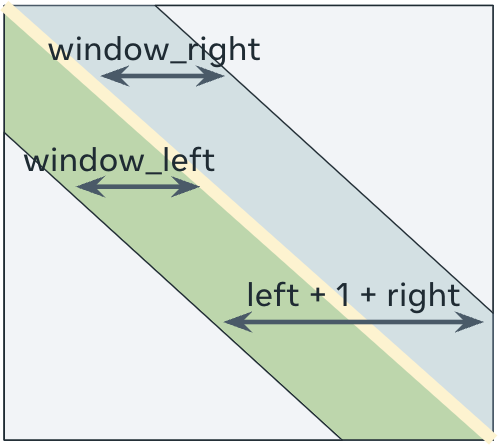
The total window size is \(window\_left + 1 + window\_right\)¶
- class xformers.ops.fmha.attn_bias.LowerTriangularFromBottomRightMask[source]¶
Bases:
AttentionBiasA causal masking.
This mask is exactly the same as
LowerTriangularMaskwhen there is the same number of queries and keys. When the number of queries is different from the number of keys, it is a triangular mask shifted so that the last query can attend to the last key. In other words, a query Q cannot attend to a key which is nearer the final key than Q is to the final query.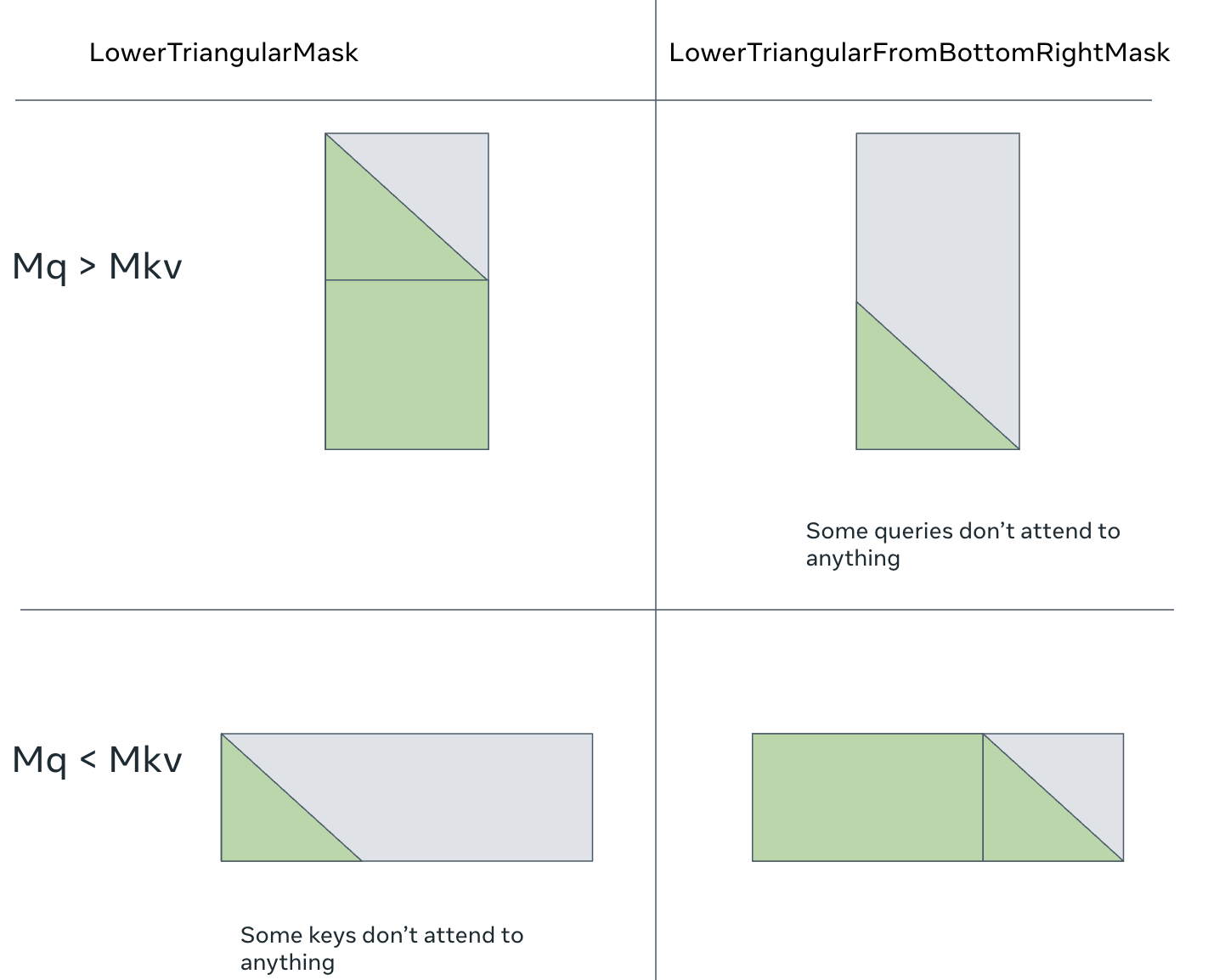
The difference between
LowerTriangularMask(left) andLowerTriangularFromBottomRightMask(right). They become equivalent if the number of queries equals the number of keys.¶- make_local_attention(window_size: int) LowerTriangularFromBottomRightLocalAttentionMask[source]¶
Create a new bias which combines local + causal attention.
- class xformers.ops.fmha.attn_bias.LowerTriangularFromBottomRightLocalAttentionMask(_window_size: int)[source]¶
Bases:
LowerTriangularFromBottomRightMaskA mask that combines both
LowerTriangularFromBottomRightMaskand local attention.A query whose distance from the final query is X cannot attend to a key whose distance to the final key is either of:
less than X (i.e. “causal attention”, same as
LowerTriangularFromBottomRightMask)greater than or equal to X + window_size (i.e. “local attention”)
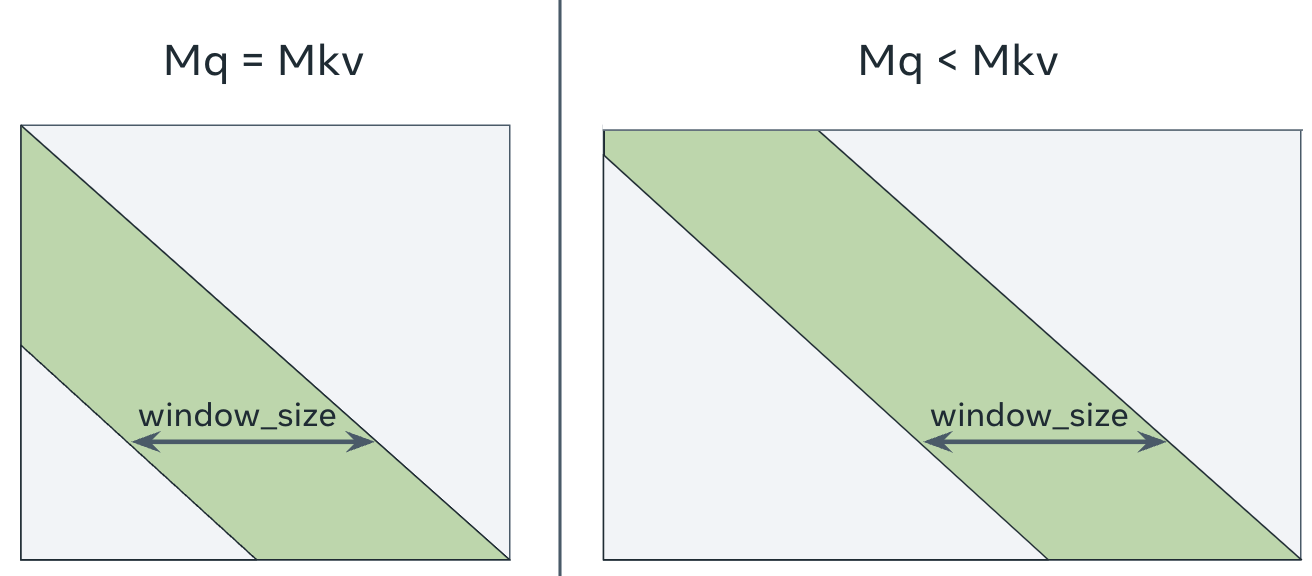
The mask from
LowerTriangularFromBottomRightLocalAttentionMask. The green area is calculated, and the grey area is masked out.¶
- class xformers.ops.fmha.attn_bias.LowerTriangularMaskWithTensorBias(bias: Tensor)[source]¶
Bases:
LowerTriangularMaskA lower-triangular (aka causal) mask with an additive bias
- class xformers.ops.fmha.attn_bias.BlockDiagonalMask(q_seqinfo: _SeqLenInfo, k_seqinfo: _SeqLenInfo, _batch_sizes: Optional[Sequence[int]] = None)[source]¶
Bases:
AttentionBiasA block-diagonal mask that can be passed as
attn_biasargument toxformers.ops.memory_efficient_attention.Queries and Keys are each divided into the same number of blocks. Queries in block i only attend to keys in block i.
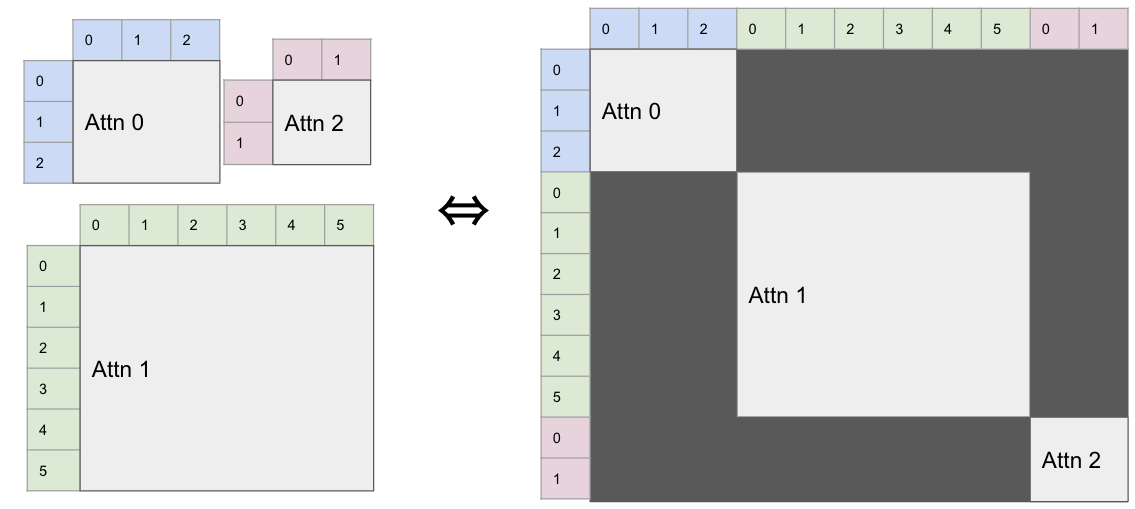
This bias can be used to handle a batch of sequences of different lengths, via
BlockDiagonalMask.from_tensor_list¶- Example
import torch from xformers.ops import fmha K = 16 dtype = torch.float16 device = "cuda" list_x = [ torch.randn([1, 3, 1, K], dtype=dtype, device=device), torch.randn([1, 6, 1, K], dtype=dtype, device=device), torch.randn([1, 2, 1, K], dtype=dtype, device=device), ] attn_bias, x = fmha.BlockDiagonalMask.from_tensor_list(list_x) linear = torch.nn.Linear(K, K * 3).to(device=device, dtype=dtype) q, k, v = linear(x).reshape([1, -1, 1, 3, K]).unbind(-2) out = fmha.memory_efficient_attention(q, k, v, attn_bias=attn_bias) list_out = attn_bias.split(out) print(list_out[0].shape) # [1, 3, 1, K] assert tuple(list_out[0].shape) == (1, 3, 1, K)
- materialize(shape: Tuple[int, ...], dtype: dtype = torch.float32, device: Union[str, device] = 'cpu') Tensor[source]¶
Materialize the attention bias - for debugging & testing
- classmethod from_seqlens(q_seqlen: Sequence[int], kv_seqlen: Optional[Sequence[int]] = None, *, device: Optional[device] = None) BlockDiagonalMask[source]¶
Creates a
BlockDiagonalMaskfrom a list of tensors lengths for query and key/value.
- classmethod from_tensor_list(tensors: Sequence[Tensor]) Tuple[BlockDiagonalMask, Tensor][source]¶
Creates a
BlockDiagonalMaskfrom a list of tensors, and returns the tensors concatenated on the sequence length dimension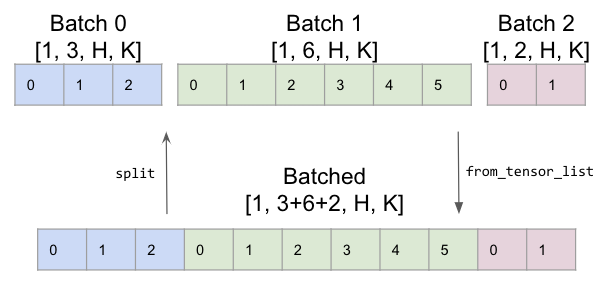
See also
BlockDiagonalMask.splitto split the returnedtorch.Tensorback to a list of tensors of varying sequence length¶- Parameters
tensors (Sequence[torch.Tensor]) – A list of tensors of shape
[B, M_i, *]. All tensors should have the same dimension and the same batch sizeB, but they can have different sequence lengthM.- Returns
Tuple[BlockDiagonalMask, torch.Tensor] – The corresponding bias for the attention along with tensors concatenated on the sequence length dimension, with shape
[1, sum_i{M_i}, *]
- split(tensor: Tensor) Sequence[Tensor][source]¶
The inverse operation of
BlockDiagonalCausalMask.from_tensor_list- Parameters
tensor (torch.Tensor) – Tensor of tokens of shape
[1, sum_i{M_i}, *]- Returns
Sequence[torch.Tensor] – A list of tokens with possibly different sequence lengths
- make_causal() BlockDiagonalCausalMask[source]¶
Makes each block causal
- make_causal_from_bottomright() BlockDiagonalCausalFromBottomRightMask[source]¶
Makes each block causal with a possible non-causal prefix
- make_local_attention(window_size: int) BlockDiagonalCausalLocalAttentionMask[source]¶
Experimental: Makes each block causal with local attention
- make_local_attention_from_bottomright(window_size: int) BlockDiagonalCausalLocalAttentionFromBottomRightMask[source]¶
Experimental: Makes each block causal with local attention, start from bottom right
- class xformers.ops.fmha.attn_bias.BlockDiagonalCausalMask(q_seqinfo: _SeqLenInfo, k_seqinfo: _SeqLenInfo, _batch_sizes: Optional[Sequence[int]] = None)[source]¶
Bases:
BlockDiagonalMaskSame as
xformers.ops.fmha.attn_bias.BlockDiagonalMask, except that each block is causal.Queries and Keys are each divided into the same number of blocks. A query Q in block i cannot attend to a key which is not in block i, nor one which is farther from the initial key in block i than Q is from the initial query in block i.
- class xformers.ops.fmha.attn_bias.BlockDiagonalCausalFromBottomRightMask(q_seqinfo: _SeqLenInfo, k_seqinfo: _SeqLenInfo, _batch_sizes: Optional[Sequence[int]] = None)[source]¶
Bases:
BlockDiagonalMaskSame as
xformers.ops.fmha.attn_bias.BlockDiagonalMask, except that each block is causal. This mask allows for a non-causal prefix NOTE: Each block should have num_keys >= num_queries otherwise the forward pass is not defined (softmax of vector of -inf in the attention)Queries and keys are each divided into the same number of blocks. A query Q in block i cannot attend to a key which is not in block i, nor one which nearer the final key in block i than Q is to the final query in block i.
- class xformers.ops.fmha.attn_bias.BlockDiagonalPaddedKeysMask(q_seqinfo: _SeqLenInfo, k_seqinfo: _PaddedSeqLenInfo)[source]¶
Bases:
AttentionBiasSame as
xformers.ops.fmha.attn_bias.BlockDiagonalMask, except we support padding for k/vThe keys and values are divided into blocks which are padded out to the same total length. For example, if there is space for 12 keys, for three blocks of max length 4, but we only want to use the first 2, 3 and 2 of each block, use kv_padding=4 and kv_seqlens=[2, 3, 2]. The queries are divided into blocks, without padding, of lengths given by q_seqlen.
A query Q in block i cannot attend to a key which is not in block i, nor one which is not in use (i.e. in the padded area).
- materialize(shape: Tuple[int, ...], dtype: dtype = torch.float32, device: Union[str, device] = 'cpu') Tensor[source]¶
Materialize the attention bias - for debugging & testing
- classmethod from_seqlens(q_seqlen: Sequence[int], kv_padding: int, kv_seqlen: Sequence[int], causal_diagonal: Optional[Any] = None, *, device: Optional[device] = None) BlockDiagonalPaddedKeysMask[source]¶
Creates a
BlockDiagonalPaddedKeysMaskfrom a list of tensor lengths for query and key/value.- Parameters
- Returns
BlockDiagonalPaddedKeysMask
- class xformers.ops.fmha.attn_bias.BlockDiagonalCausalWithOffsetPaddedKeysMask(q_seqinfo: _SeqLenInfo, k_seqinfo: _PaddedSeqLenInfo, causal_diagonal: Optional[Any] = None)[source]¶
Bases:
BlockDiagonalPaddedKeysMaskSame as
xformers.ops.fmha.attn_bias.BlockDiagonalCausalMask, except an offset on causality is allowed for each block and we support padding for k/vThe keys and values are divided into blocks which are padded out to the same total length. For example, if there is space for 12 keys, for three blocks of max length 4, but we only want to use the first 2, 3 and 2 of each block, use kv_padding=4 and kv_seqlens=[2, 3, 2]. The queries are divided into blocks, without padding, of lengths given by q_seqlen.
A query Q in block i cannot attend to a key which is not in block i, nor one which is not in use (i.e. in the padded area), nor one which is nearer to the final key in block i than Q is to the final query in block i.
- classmethod from_seqlens(q_seqlen: Sequence[int], kv_padding: int, kv_seqlen: Sequence[int], causal_diagonal: Optional[Any] = None, *, device: Optional[device] = None) BlockDiagonalCausalWithOffsetPaddedKeysMask[source]¶
Creates a
BlockDiagonalCausalWithOffsetPaddedKeysMaskfrom a list of tensor lengths for query and key/value.- Parameters
- Returns
BlockDiagonalCausalWithOffsetPaddedKeysMask
- class xformers.ops.fmha.attn_bias.BlockDiagonalLocalAttentionPaddedKeysMask(q_seqinfo: _SeqLenInfo, k_seqinfo: _PaddedSeqLenInfo, window_left: int, window_right: int)[source]¶
Bases:
BlockDiagonalPaddedKeysMaskLike
xformers.ops.fmha.attn_bias.BlockDiagonalCausalLocalAttentionPaddedKeysMask, except that this is non-causal.A query Q in block i cannot attend to a key which is not in block i, nor one which is not in use (i.e. in the padded area), nor one whose distance to the final key in block i is more than window_left further or window_right nearer than Q is to the final query in block i.
A query attends to at most window_left + window_right - 1 keys.
NOTE that if window_right is 0, then this is like a BlockDiagonalCausalLocalAttentionPaddedKeysMask whose window_size is equal to window_left - 1.
- class xformers.ops.fmha.attn_bias.BlockDiagonalCausalLocalAttentionPaddedKeysMask(q_seqinfo: _SeqLenInfo, k_seqinfo: _PaddedSeqLenInfo, _window_size: int)[source]¶
Bases:
BlockDiagonalPaddedKeysMaskLike
xformers.ops.fmha.attn_bias.BlockDiagonalCausalWithOffsetPaddedKeysMask, except with a window size.A query Q in block i cannot attend to a key which is not in block i, nor one which is not in use (i.e. in the padded area), nor one which is nearer to the final key in block i than Q is to the final query in block i, nor one that is at least window_size further from the final key in block i than Q is to the final query in block i.
- class xformers.ops.fmha.attn_bias.PagedBlockDiagonalPaddedKeysMask(q_seqinfo: _SeqLenInfo, k_seqinfo: _PaddedSeqLenInfo, block_tables: Tensor, page_size: int)[source]¶
Bases:
AttentionBiasSame as BlockDiagonalPaddedKeysMask, but for paged attention. block_tables has shape [batch_size, max_num_pages] and K/V have shape [1, max_num_pages * page_size, num_heads, head_dim] or [1, max_num_pages * page_size, num_groups, num_heads, head_dim]
- materialize(shape: Tuple[int, ...], dtype: dtype = torch.float32, device: Union[str, device] = 'cpu') Tensor[source]¶
Materialize the attention bias - for debugging & testing
- classmethod from_seqlens(q_seqlen: Sequence[int], kv_seqlen: Sequence[int], block_tables: Tensor, page_size: int, *, device: Optional[device] = None) PagedBlockDiagonalPaddedKeysMask[source]¶
Creates a
PagedBlockDiagonalPaddedKeysMaskfrom a list of tensor lengths for query and key/value.- Parameters
- Returns
PagedBlockDiagonalPaddedKeysMask
- class xformers.ops.fmha.attn_bias.PagedBlockDiagonalCausalWithOffsetPaddedKeysMask(q_seqinfo: _SeqLenInfo, k_seqinfo: _PaddedSeqLenInfo, block_tables: Tensor, page_size: int)[source]¶
Bases:
PagedBlockDiagonalPaddedKeysMaskSame as BlockDiagonalCausalWithOffsetPaddedKeysMask, but for paged attention. block_tables has shape [batch_size, max_num_pages] and K/V have shape [1, max_num_pages * page_size, num_heads, head_dim] or [1, max_num_pages * page_size, num_groups, num_heads, head_dim]
- class xformers.ops.fmha.attn_bias.BlockDiagonalGappyKeysMask(q_seqinfo: _SeqLenInfo, k_seqinfo: _GappySeqInfo)[source]¶
Bases:
AttentionBiasSame as
xformers.ops.fmha.attn_bias.BlockDiagonalMask, except k/v is gappy.A query Q in block i only attends to a key which is in block i.
- materialize(shape: Tuple[int, ...], dtype: dtype = torch.float32, device: Union[str, device] = 'cpu') Tensor[source]¶
Materialize the attention bias - for debugging & testing
- classmethod from_seqlens(q_seqlen: Sequence[int], kv_seqstarts: Sequence[int], kv_seqlen: Sequence[int], *, device: Optional[device] = None) BlockDiagonalGappyKeysMask[source]¶
Creates a
BlockDiagonalGappyKeysMaskfrom a list of tensor lengths for query and key/value.
- make_paged(block_tables: Tensor, page_size: int, notional_padding: int, paged_type: Type[PagedBlockDiagonalGappyKeysMask]) AttentionBias[source]¶
Assuming our keys actually live in separate blocks of length notional_padding, convert to a Paged version, avoiding GPU syncs.
- class xformers.ops.fmha.attn_bias.BlockDiagonalCausalWithOffsetGappyKeysMask(q_seqinfo: _SeqLenInfo, k_seqinfo: _GappySeqInfo)[source]¶
Bases:
BlockDiagonalGappyKeysMaskSame as
xformers.ops.fmha.attn_bias.BlockDiagonalCausalMask, except k/v is gappy.A query Q in block i cannot attend to a key which is not in block i, nor one which is nearer to the final key in block i than Q is to the final query in block i.
- class xformers.ops.fmha.attn_bias.PagedBlockDiagonalGappyKeysMask(q_seqinfo: _SeqLenInfo, k_seqinfo: _GappySeqInfo, block_tables: Tensor, page_size: int)[source]¶
Bases:
AttentionBiasEquivalent BlockDiagonalGappyKeysMask, but for paged attention. block_tables has shape [batch_size, max_num_pages] and K/V have shape [1, max_num_pages * page_size, num_heads, head_dim] or [1, max_num_pages * page_size, num_groups, num_heads, head_dim]
- materialize(shape: Tuple[int, ...], dtype: dtype = torch.float32, device: Union[str, device] = 'cpu') Tensor[source]¶
Materialize the attention bias - for debugging & testing
- classmethod from_seqlens(q_seqlen: Sequence[int], kv_seqstarts: Sequence[int], kv_seqlen: Sequence[int], block_tables: Tensor, page_size: int, *, device: Optional[device] = None) PagedBlockDiagonalGappyKeysMask[source]¶
Creates a
PagedBlockDiagonalGappyKeysMaskfrom a list of tensor lengths for query and key/value.Note that unlike
BlockDiagonalGappyKeysMask, kv_seqstarts is addressing in a different space for each batch element. For example if you were doing a BlockDiagonalPaddedKeysMask with two batch elements and padding=100, but wanted to change it so that the first key is ignored, then you would use BlockDiagonalGappyKeysMask with kv_seqstarts [1, 101, 200]. But if you were using PagedBlockDiagonalPaddedKeysMask but wanted to ignore the first key, you would provide this function with kv_seqstarts = [1, 1].
- class xformers.ops.fmha.attn_bias.PagedBlockDiagonalCausalWithOffsetGappyKeysMask(q_seqinfo: _SeqLenInfo, k_seqinfo: _GappySeqInfo, block_tables: Tensor, page_size: int)[source]¶
Bases:
PagedBlockDiagonalGappyKeysMaskSame as BlockDiagonalCausalWithOffsetGappyKeysMask, but for paged attention. block_tables has shape [batch_size, max_num_pages] and K/V have shape [1, max_num_pages * page_size, num_heads, head_dim] or [1, max_num_pages * page_size, num_groups, num_heads, head_dim]
- class xformers.ops.fmha.attn_bias.BlockDiagonalCausalLocalAttentionMask(q_seqinfo: _SeqLenInfo, k_seqinfo: _SeqLenInfo, _batch_sizes: Optional[Sequence[int]] = None, _window_size: int = 0)[source]¶
Bases:
BlockDiagonalCausalMask(Experimental feature) Same as
xformers.ops.fmha.attn_bias.BlockDiagonalCausalMask. This makes the mask “local” and the attention pattern banded.The ith query in a block only attends to keys in its block with index greater than i - window_size and less than or equal to i.
- class xformers.ops.fmha.attn_bias.BlockDiagonalCausalLocalAttentionFromBottomRightMask(q_seqinfo: _SeqLenInfo, k_seqinfo: _SeqLenInfo, _batch_sizes: Optional[Sequence[int]] = None, _window_size: int = 0)[source]¶
Bases:
BlockDiagonalCausalFromBottomRightMask(Experimental feature) Same as
xformers.ops.fmha.attn_bias.BlockDiagonalCausalMask. This makes the mask “local” and the attention pattern banded.A query with distance j from the last query in its block only attends to keys in the same block, and only those whose distance to the last key in the block is greater than or equal to j and less than window_size + j.
Partial Attention¶
- xformers.ops.fmha.memory_efficient_attention_partial(query: Tensor, key: Tensor, value: Tensor, attn_bias: Optional[Union[Tensor, AttentionBias]] = None, p: float = 0.0, scale: Optional[float] = None, *, op: Optional[Union[Tuple[Optional[Type[AttentionFwOpBase]], Optional[Type[AttentionBwOpBase]]], Type[AttentionFwOpBase]]] = None, output_dtype: Optional[dtype] = None) Tuple[Tensor, Tensor][source]¶
Returns a tuple (output, lse), where output is the attention in the style of memory_efficient_attention, and lse is extra data, a log-sum-exp. The outputs of calls to this with the same query and separate keys and values can be merged with merge_attentions to obtain the attention of the queries against the disjoint union of the keys and values.
This function doesn’t have a backward pass.
- xformers.ops.fmha.merge_attentions(attn_split: Union[Tensor, Sequence[Tensor]], lse_split: Union[Tensor, Sequence[Tensor]], write_lse: bool = True, output_dtype: Optional[dtype] = None) Tuple[Tensor, Optional[Tensor]][source]¶
Combine attention output computed on different parts of K/V for the same query to get attention on the whole K/V. See https://arxiv.org/abs/2402.05099 The result is equal to
Out_full = (Out1 * exp(LSE1) + Out2 * exp(LSE2) + …) / (exp(LSE1) + exp(LSE2) + …) LSE_full = log(exp(LSE1) + exp(LSE2) + …)
- Parameters
attn_split – attention outputs for chunks, either as a list of tensors of shapes [B, M, G, H, Kq] or [B, M, H, Kq] or as a single tensor of shape [num_chunks, B, M, G, H, Kq] or [num_chunks, B, M, H, Kq]
lse_split – LSE for chunks, either as a list of tensors of shapes [B, G, H, M] or [B, H, M] or as a single tensor of shape [num_chunks, B, G, H, M] or [num_chunks, B, H, M]
write_lse – whether to output LSE
output_dtype – dtype of attn_out
- Returns
attn_out – [B, M, G, H, Kq] or [B, M, H, Kq] lse_out: [B, G, H, M] or [B, H, M] if write_lse
or None otherwise
Non-autograd implementations¶
- xformers.ops.fmha.memory_efficient_attention_backward(grad: Tensor, output: Tensor, lse: Tensor, query: Tensor, key: Tensor, value: Tensor, attn_bias: Optional[Union[Tensor, AttentionBias]] = None, p: float = 0.0, scale: Optional[float] = None, *, op: Optional[Type[AttentionBwOpBase]] = None) Tuple[Tensor, Tensor, Tensor][source]¶
Computes the gradient of the attention. Returns a tuple (dq, dk, dv) See
xformers.ops.memory_efficient_attentionfor an explanation of the arguments. lse is the tensor returned byxformers.ops.memory_efficient_attention_forward_requires_grad
- xformers.ops.fmha.memory_efficient_attention_forward(query: Tensor, key: Tensor, value: Tensor, attn_bias: Optional[Union[Tensor, AttentionBias]] = None, p: float = 0.0, scale: Optional[float] = None, *, op: Optional[Type[AttentionFwOpBase]] = None, output_dtype: Optional[dtype] = None) Tensor[source]¶
Calculates the forward pass of
xformers.ops.memory_efficient_attention.
- xformers.ops.fmha.memory_efficient_attention_forward_requires_grad(query: Tensor, key: Tensor, value: Tensor, attn_bias: Optional[Union[Tensor, AttentionBias]] = None, p: float = 0.0, scale: Optional[float] = None, *, op: Optional[Type[AttentionFwOpBase]] = None, output_dtype: Optional[dtype] = None) Tuple[Tensor, Tensor][source]¶
Returns a tuple (output, lse), where lse can be used to compute the backward pass later. See
xformers.ops.memory_efficient_attentionfor an explanation of the arguments Seexformers.ops.memory_efficient_attention_backwardfor running the backward pass

